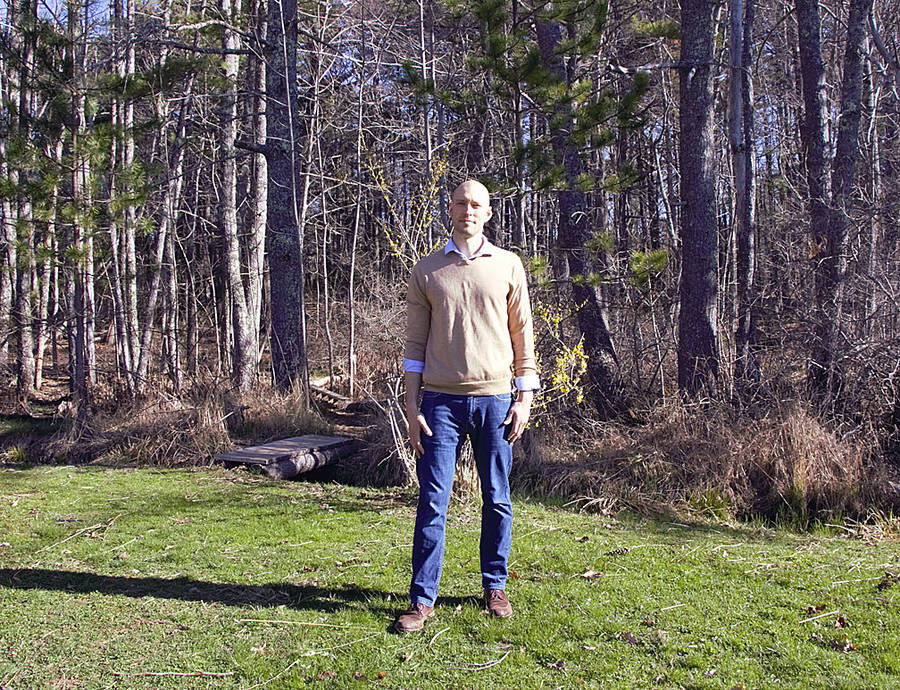
2021-04-21
Life after Northern Pulp
by JANET WHITMANCommunities around the province are quietly working on bold new proposals to heat entire towns by burning truckloads of pulpwood and sawmill scraps once gobbled up by Pictou County's Northern Pulp mill.
And a bio-energy consultant living in Mahone Bay is behind the effort.
Jamie Stephen, who recently moved to the South Shore town from Ontario, has spent the past several months planting seeds for the idea with municipal and town councils. So far, New Glasgow, Digby and Argyle have signed on and are applying for government funding for feasibility studies that could get multi-million-dollar infrastructure projects shovel ready.
Those communities would just be the beginning, Stephen told LighthouseNOW from his new home office. The bio-energy consultant uprooted from Ottawa with his wife and three young daughters in November precisely because of the opportunity created in Nova Scotia with Northern Pulp's shutdown and the threat of climate change.
He estimates Nova Scotia has the potential for more than $5 billion worth of biomass-fuelled "district energy systems" eligible for government infrastructure funding that would cover the bulk of the cost.
While he believes the Brooklyn Energy plant in Queens County is poised for optimization. (More on this next issue.)
The networks of underground hot water pipes connecting central boilers to buildings are hugely popular in Northern Europe as a source of green energy heating entire cities. But the biomass-fueled systems haven't caught on in Canada because of misconceptions about their efficiency and carbon footprint.
Building out the energy infrastructure could take a few years. But Stephen sees other, near-term opportunities to take advantage of the availability of biomass, including potential for the Brooklyn Energy plant in Queens County. (More on this next issue.)
With the right uptake, Nova Scotia could slash its greenhouse gas emissions by 40 per cent, and eliminate the need to import coal, natural gas and propane for heat, according to Stephen. Widespread burning of locally produced, sustainable biomass could become the necessary ingredient for a thriving, ecological forestry industry that's been missing since Northern Pulp shuttered and stopped buying sawmill residues and low-grade wood that are by-products of forestry.
He says the energy infrastructure projects would create new high-paying jobs for boilermakers, pipefitters, and other soon-to-be displaced oil industry workers, while eliminating the alternative of retraining them for $20-an-hour positions installing solar panels. The vastly cheaper fuel source could help people suffering from energy poverty, a situation set to worsen as Prime Minister Justin Trudeau hikes carbon taxes in 2030.
"Municipal-owned district energy just makes a lot of sense," says Stephen. Founder and managing director of TorchLight Bioresources, he has 18 years experience in consulting and research in the bio-energy field. "It allows you to utilize a local resource and creates a huge number of jobs. Over $1 billion a year could remain in province to be spent on local wood fuel, rather than spent on importing oil, natural gas, and coal." The figure doesn't include the indirect job creation and economic development associated with forestry and new energy infrastructure.
The response from municipalities has been "very positive," according to Stephen, whose clients also include national and provincial governments, First Nations, utilities, airlines, bioenergy producers and industry associations. "They have recognized the value of district energy and the ability to utilize local, low-carbon fuel to support local economies and employment in the forestry and utility sectors."
Infrastructure money from Ottawa and the province could cover 73.3 per cent of the cost for municipality-owned energy systems. The hitch is towns and municipalities lack the financial resources to pay for the required feasibility studies for the energy system-changing infrastructure. Development of a community-wide district energy system, as New Glasgow and Digby are mulling, could be the largest capital projects in each's history.
Stephen worked with Federation of Nova Scotia Woodland Owners executive director Pat Wiggin to help New Glasgow put together a proposal seeking around $400,000 for a feasibility study.
The province's $50-million forestry transition fund, set up to help the industry after Northern Pulp's closure, rejected the request in early February.
"It was disappointing. I think we put together a pretty wicked proposal," says Wiggin, a Dartmouth native who returned home in 2019 to take the job with the woodland owners after a decade of managing tree-planting projects in northern British Columbia. "One of the reasons we pitched New Glasgow is that, although it's rural, it's got a pretty concentrated community. It's also an area where hundreds of families have been affected by the Northern Pulp closure."
Undeterred, New Glasgow chief administrative officer Lisa MacDonald and climate change and sustainability manager Rachel Mitchell plan to apply again, with the enthusiastic support of Mayor Nancy Dicks and the rest of town council.
Meanwhile, Argyle, with its much lower population density, is taking a different tack. The municipality is proposing to buy pellet-burning boilers and install them in houses. Its ownership, with backing from the federal and provincial governments, would help offset the roughly $27,000 expense per boiler, a cost-prohibitive upfront price tag for most homeowners. The significant savings of using a much cheaper and greener fuel would pay out over time. The municipality, as owner of the utility, would get a cut.
Stephen told Argyle councillors earlier this year that the municipality could serve as a case study to be replicated in similar communities throughout the province, with wood pellets supplied by the Shaw Group's Shubenacadie-based Shaw Resources and stored in a large silo. He explained that utilizing wood pellets at home is vastly cheaper and three times as efficient as getting power from either coal or biomass burned at a power plant. "It is the proven approach for carbon reduction. In Europe, they have over 200 million tons per year of CO2 reductions. To put that into perspective, Nova Scotia's total greenhouse gas emissions are 17 million."
Digby's feasibility study application will be led by Bridgewater-based WestFor Management Inc., established by the province in 2016 to boost the efficiency of Crown land forestry management.
Stephen is also pitching to Antigonish. Working in partnership with St. Francis Xavier University, the town is racing to be the first net-zero emissions community in Canada powered by 100 per cent renewable energy.
After the New Glasgow rejection for a sliver of the $50-million forestry transition fund, the forestry sector is working on a letter to send to Lands and Forestry Minister Chuck Porter to underscore the need for fully funded feasibility studies for municipalities.
Ian Rankin told Advocate Media in an interview after he was elected Nova Scotia Premier that he'd like to expand a program he rolled out as forestry minister in the fall to use wood chips to heat six public buildings, including the Provincial Court building and NSCC Lunenburg Campus in Bridgewater. Combined, the six buildings would consume about 5,000 tonnes a year, less than 0.4 per cent of the wood fibre consumed by Northern Pulp.
Stephen spoke with Rankin before the election to discuss the potential for district energy systems. "His primary concern is what people are going to think about burning wood," says Stephen. "I completely understand where he's coming from. It's a communications thing."
To help on that front, the Federation of Nova Scotia Woodland Owners was awarded a $215,000 grant from Natural Resources Canada's Forest Innovation Program to examine the social acceptability of active forest management, bioheat and district energy, a study Stephen is helping out on.
"Looking across country as to where greatest opportunity is to actually shift towards development, which is really where I'm looking to go, Nova Scotia makes the most sense both on the forestry and energy side," says Stephen.
When it comes to heat, Nova Scotians, with their electric baseboard heaters and oil-fired furnaces, pay some of the highest prices in the country. Heating oil is poised to jump by 60 cents a litre by 2030 as new carbon taxes are imposed.
With the closure of Northern Pulp, the forestry industry lost the buyer of as much as 90 per cent of its wood shavings, bark, and other low-grade wood fibre. The lost market has delivered a blow to sawmills (which, so far, has been masked by a surprise lumber boom amid the coronavirus pandemic) and the ability of the industry to manage the forests in a stable, ecological manner.
Wiggin is a vehement opponent of clearcutting. He says his main job is to manage forests for the future and make sure Nova Scotia landowners "always have some sort of security blanket of offtake" for wood chips and other low-grade by-products, whether to a mill or a boiler.
"In a country where more than 80 per cent of energy demand is heat, you'd think all of these light bulbs would be going off," he says. "You'd think they might say, 'Hey, maybe we should use what we have and solve these internal problems we have in provinces with the loss of major pulp clients."
(Next week: Potential for Brooklyn Energy, and reaction from environmentalists)
Janet Whitman is a contributing editor and staff reporter with Advocate Media.







